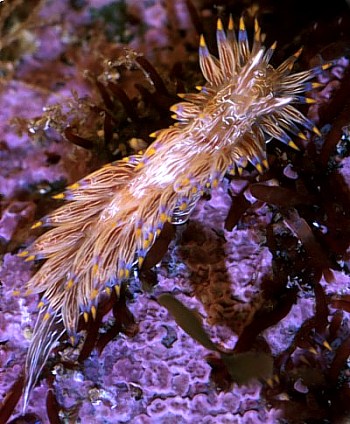
Janolus eximius
Miller & Willan, 1986
Order: NUDIBRANCHIA
Suborder: ARMININA
Family: Zephyrinidae
DISTRIBUTION
Restricted to New Zealand, where it is known only from the Three Kings group of islands in the far north and the northeastern coast of the North Island. Its depth range is from 10 to 30 metres.
PHOTO
19 mm specimen from 20 metres, Three Kings Islands, New Zealand, 30 January 1985. Photo: Richard Willan.
Janolus eximius has never been found off its food – the large, clumping bryozoan Orthoscuticella aff. margaritacea. This explains why it is unknown to most people. Janolus ignis lives on this same bryozoan, and sometimes both J. eximius and J. ignis can be found living inside the same clump. J. ignis emerges at night to eat the tips of the bryozoan, but J. eximius remains inside the clump all the time. J. eximius grows to about 20 mm.
The cerata of Janolus eximius, which are slender and circular in cross section, are completely smooth and their tips are pointed. A digestive diverticulum extends, as a smooth central rod, to the tip of every ceras. The colouration of Janolus eximius is characterised by numerous, short, white streaks. The cerata are translucent, capped with gold, and encircled by a dark blue ring below the cap, and the lower two-thirds has numerous longitudinal white streaks. Janolus eximius is able to cast off (autotomise) its cerata, which it does very readily. Once autotomised, they writhe about and stick together in clumps.
References:
• Miller, M.C. & Willan, R.C. (1986) A review of the New Zealand arminacean nudibranchs (Opisthobranchia: Arminacea). New Zealand Journal of Zoology, 13: 377-408.
Willan, R.C., 2001 (June 7) Janolus eximius Miller & Willan, 1986. [In] Sea Slug Forum. Australian Museum, Sydney. Available from http://www.seaslugforum.net/factsheet/janoexim
